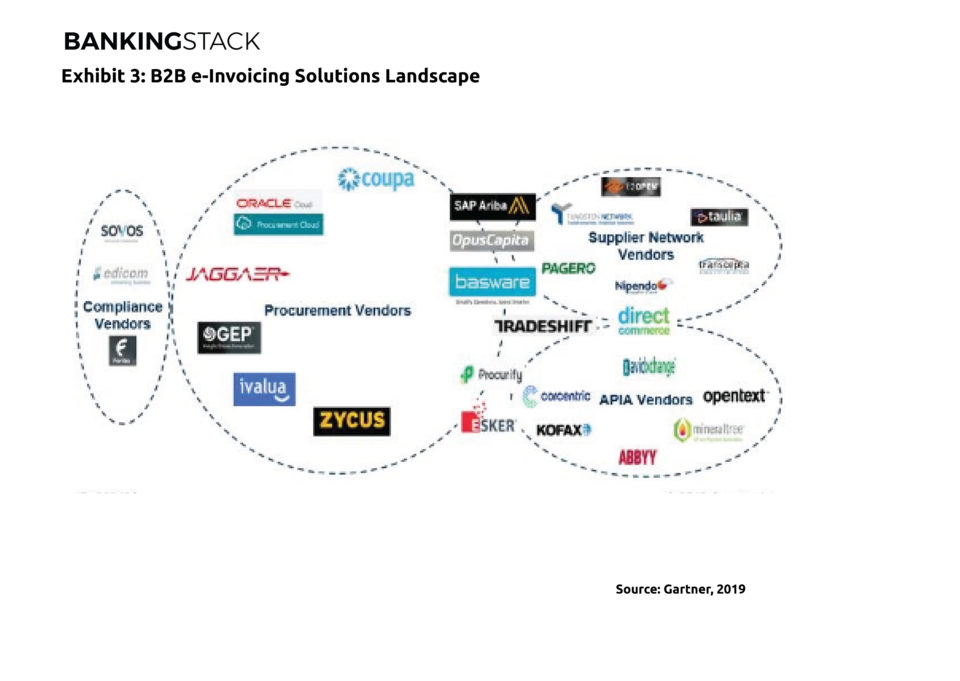The global adoption of e-invoicing coincides with a growing dependence on supply chain finance solutions fuelled by digital data. Banks, for whom trade finance has largely been a concentrated market, have a unique opportunity to enter the fray. e-Invoicing automation can help banks deliver much needed trade finance solutions embedded within their SME digital banking suites.
According to the International Chamber of Commerce (ICC), 90% of the traditional trade finance market is served by 13 banks. However, the landscape of traditional trade finance, comprising instruments like letters of credit (LCs), documentary credit and guarantees, itself has been shifting. Data shows that the share of global trade using documentary credit declined from 50% in the 1970s to an estimated 15% in 2018. LCs have similarly seen a negative growth trend since 2014, and had fallen 2.7% by 2018.
On the other hand, supply chain finance (SCF) solutions, fuelled by the growing integration of physical (logistics) and financial trade data, are seeing increasing traction. According to data from the Bank for International Settlements (BIS), an estimated 80% of global trade happens on open account transactions, which in turn facilitate supply chain finance.
In this scenario, the growing adoption of e-invoicing and the resulting automation in verification, tax reporting, and invoice management is proving to be the perfect catalyst for data-driven supply chain finance solutions.
For banks globally, supply chain finance is an emerging area of interest. An ICC global survey of 251 banks in 2018 found that only 15% of the banks’ trade finance related activities pertained to supply chain finance. With this immense scope for growth, banks today have the opportunity to integrate e-invoicing solutions into their treasury management and commercial banking offerings, and use this to scale supply chain offerings to both, corporate clients and underserved SME businesses.
Understanding the Global Landscape for e-Invoicing
e-Invoicing today stands for a lot more than digitalised, structured invoice data; it has fuelled an entire ecosystem of solutions around use cases like real-time continuous transaction controls and clearance, with suppliers and buyers exchanging invoices via centralised government infrastructure. e-Invoicing mandates worldwide are pushing markets, especially supply chain solution providers, to adopt standardisation and digitisation of invoices across business to business (B2B), business to government (B2G), and government to business (G2B) scenarios. As shown in Exhibit 1, maturity of e-invoicing adoption is not restricted to developed markets. Developing markets demonstrate that government mandates for e-invoices are the biggest enablers for their growing potential.

According to a Billentis market report, approximately five billion B2B e-invoices are expected to be processed globally in 2022 via service providers (Exhibit 2). Asia Pacific (APAC) is predicted to be the most promising market for e-invoicing growth due to strong acceleration with high growth rates in consumer, business and government segments.

Addressing Supply Chain Finance Challenges with e-Invoicing Automation
The global e-invoicing solution, service provider and enabling market was estimated at a value of USD 8.74 Billion in 2021 and is expected to reach USD 29.68 Billion by 2027 at a CAGR of 21.5% during 2022-27. As seen in Exhibit 3, this landscape is currently dominated by technology solutions providers, and fintechs, who are essentially serving as tech facilitators.

Large scale government e-invoicing mandates like India’s GST are leading to digitisation of supply-chain finance. Large ERP solution providers have launched integrated plug-ins for creating compliant e-invoices for multiple countries and also integrated tax filing formats. However, gaps in a fully digital, seamless experience for both, buyers and sellers still exist due to fragmentation of delivery, fragmentation of the underlying assets, limited credit and expertise, and cross-border friction due to geopolitical tensions.
e-Invoicing automation, especially when integrated with a bank’s cash and treasury management services has the potential to address some of the most persistent fragmentation challenges.
 |
||
|---|---|---|
| Table 1: e-Invoicing Automation Can Address Persistent SCF Challenges | ||
| Challenge | Impact | How e-Invoicing Can Help |
| Automation & Straight Through Processing | Data fragmentation across ERP systems, procurement systems, government tax filing platforms and core banking systems prevent the creation of a real-time, validated pool of data. | End-to-end procure-to-pay automation around government validated e-invoices, integrated with banking and payment services can enable the delivery of high value-add capabilities like purchase returns, invoice scheduling, and payment of recurring invoices. |
| Data Authentication | Large B2B payments are high on risk, particularly with new suppliers or ones with no availability of published revenue reports. Invoice approval processes are thus long, cumbersome, need thorough checking and internal review, legal status and sanctions screening, etc. Many buyers still have manual supplier onboarding processes. | Data on e-invoicing history enables AI and ML based solutions for data and identity authentication. |
| Reconciliation | Payables and receivables vary widely in terms, duration, and underlying creditworthiness, creating complexities in deciding SCF terms. Automatic matching of payments and invoices across B2B payments is only available on supplier portals offered by a few banks and financial institutions to corporate customers. | Financial automation capabilities (Exhibit 4) like AP/AR reconciliation, cashflow reconciliation and tax reconciliation integrated with e-invoicing, payments and banking flows can automate invoice approval as well as selection and agreement of terms for SCF offerings like reverse factoring and dynamic discounting. |
| Friction in Cross-border Procurements & Payments | Few services available today that connect both sides of the payment ecosystem – making and receiving payments across borders – into one platform.
Lack of standards and specifications for international e-invoicing interoperability is an area that requires conscious effort. |
Initiatives like Peppol (Europe) use standards, tools & specifications to enable cross-border exchange of electronic documents. Banks can play a significant role here through their already established cross-border payment networks and integrations. |
Unlocking SME Trade Finance for Banks
Banks’ participation in trade finance has traditionally been as part of services offered to large corporate buyers. In this scenario, financing has largely favoured larger suppliers, while smaller supply-chain vendors remain underserved. e-Invoicing is increasing the visibility of smaller supply-chain vendors’ financial health and transactions. Specifically, e-invoicing enables cost-efficient onboarding and servicing of SME suppliers with:
- Complete and verified due diligence and KYC with mandated tax registration
- Verified invoices and visibility into unpaid invoices
- Verified tax and invoice data available for modelling
- Potential for accounts payable/accounts receivable (AP/AR) automation
Banks are thus well placed to assess the financial health, financing requirements and credit worthiness of a larger pool of suppliers, and offer trade-centric financing services, like supply chain financing, dynamic discounting, auction marketplaces, buyer-led invoice finance, p-cards, seller auctions, factoring and invoice finance.
Corporate customers extensively use cash management and treasury services from the banks. e-Invoicing integrated into treasury management can be offered to both corporate and SME segments. Digitised and automated business processes for invoices have potential to be integrated with accounting software and offered as value added services with treasury management, like creating, scheduling, transmitting invoices to customers, bill payer services and payment services. Exhibit 4 highlights the value addition that can be created by banks with this approach.

With e-invoicing mandates and continuous transaction controls (like e-way bills in India), banks can deliver the following supply chain finance solutions to SMEs:
- Reverse Factoring: With e-invoices verified and processed in 24 hours, a larger pool of invoices gets approved by the corporate buyers. Banks can build a reverse factoring service to SME sellers with e-invoices services integrated into treasury management.
- Invoice Factoring: Invoice factoring can be directly offered to SMEs who are commercial banking clients or this sector can be served by big banks as credit worthiness and KYC can be ascertained in almost real time, even for new sellers or suppliers.
- Dynamic Discounting and Payments: Through Request-to-pay (RTP) payment services built-in as value added services in treasury management, banks can offer automated dynamic discounting opportunities list with assessing cash flow and real time AP/AR reconciliation of both buyers and sellers.
- Supplier Invoice Management: Embedding e-invoicing into online banking or commercial banking services addresses a massive pain area for SMEs of financial administration of invoices. Invoicing interoperability (for B2B and B2G) is offered only by large ERP solution providers and may not be accessible to SMEs; banks can leverage this service gap with embedded E-invoicing.
- Digital Storage or Archiving Invoices: Management and maintenance of compliance data which is archived is a weak area for SMEs. Banks offering this service can gradually help build stronger balance sheets for SMEs and bring them to pool of institutional credit financing.
Conclusion
Building capacities for supply chain finance is emerging as an important approach to serving the USD 1.5 trillion trade finance gap. SMEs, representing 45% of this gap, are an important but underserved value pool for the supply chain finance market.
The e-Invoicing public infrastructure landscape is witnessing an increasing emergence of government, public and private bodies, like TreDs (India), BPC (Oceania and Europe) and Peppol (Pan European Public Procurement Online), that are spurring innovation and integration in supply chain finance solutions across sellers and buyers, aggregators, lenders and government. Continuous transaction controls and clearance are an important piece of the e-invoicing automation enabled by this ecosystem.
Banks, with their existing trade finance and treasury management infrastructure, are well-placed to adopt these emerging capabilities, and deliver integrated business banking and supply chain finance services to SMEs and corporates alike.
References:
1) OECD, 2021, Trade Finance for SMEs in the Digital Era; https://www.oecd.org/cfe/smes/Trade%20finance%20for%20SMEs%20in%20the%20digital%20era.pdf
2) BIllentis, eInvoicing Market Review; https://www.billentis.com/einvoicing_ebilling_market_overview_2022.pdf
3) Research and Markets, E-Invoicing Market: Global Industry Trends, Share, Size, Growth, Opportunity and Forecast 2022-2027; https://www.researchandmarkets.com/reports/5547047/e-invoicing-market-global-industry-trends
4) Asian Development Bank, Trade Finance Gaps, Growth and Jobs Survey, 2019; http://dx.doi.org/10.22617/BRF190389-2








